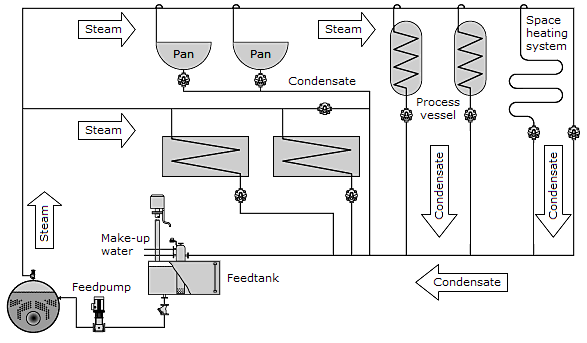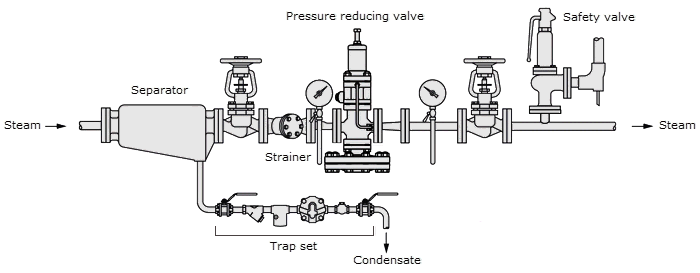Steam distribution system
An efficient steam distribution system is essential if steam of the right quality and pressure is to be supplied, in the right quantity, to the steam using equipment.
This page will look at methods of carrying steam from a central source to the point of use. The central source might be a boiler house or the discharge from a co-generation plant. The boilers may burn primary fuel, or be waste heat boilers using exhaust gases from high temperature processes, engines or even incinerators. Whatever the Reference(s), an efficient steam distribution system is essential if steam of the right quality and pressure is to be supplied, in the right quantity, to the steam using equipment. Installation and maintenance of the steam system are important issues, and must be considered at the design stage.
Steam system basics
From the outset, an understanding of the basic steam circuit, or 'steam and condensate loop' is required - see image below. As steam condenses in a process, flow is induced in the supply pipe. Condensate has a very small volume compared to the steam, and this causes a pressure drop, which causes the steam to flow through the pipes.
The steam generated in the boiler must be conveyed through pipework to the point where its heat energy is required. Initially there will be one or more main pipes, or 'steam mains', which carry steam from the boiler in the general direction of the steam using plant. Smaller branch pipes can then carry the steam to the individual pieces of equipment.

Typical basic steam circuit
When the boiler main isolating Valve (commonly called the crown Valve) is opened, steam immediately passes from the boiler into and along the steam mains to the points at lower pressure. The pipework is initially cooler than the steam, so heat is transferred from the steam to the pipe. The air surrounding the pipes is also cooler than the steam, so the pipework will begin to transfer heat to the air.
Steam on contact with the cooler pipes will begin to condense immediately. On start-up of the system, the condensing rate will be at its maximum, as this is the time where there is maximum temperature difference between the steam and the pipework.
This condensing rate is commonly called the starting load.
Once the pipework has warmed up, the temperature difference between the steam and pipework is minimal, but some condensation will occur as the pipework still continues to transfer heat to the surrounding air.
This condensing rate is commonly called the running load.
The resulting condensation (condensate) falls to the bottom of the pipe and is carried along by the steam flow and assisted by gravity, due to the gradient in the steam main that should be arranged to fall in the direction of steam flow. The condensate will then have to be drained from various strategic points in the steam main.
When the Valve on the steam pipe serving an item of steam using plant is opened, steam flowing from the distribution system enters the plant and again comes into contact with cooler surfaces. The steam then transfers its energy in warming up the equipment and product (starting load), and, when up to temperature, continues to transfer heat to the process (running load).
There is now a continuous supply of steam from the boiler to satisfy the connected load and to maintain this supply more steam must be generated. In order to do this, more water (and fuel to heat this water) is supplied to the boiler to make up for that water which has previously been evaporated into steam.
The condensate formed in both the steam distribution pipework and in the process equipment is a convenient supply of useable hot boiler feedwater. Although it is important to remove this condensate from the steam space, it is a valuable commodity and should not be allowed to run to waste. Returning all condensate to the boiler feedtank closes the basic steam loop, and should be practised wherever practical.
On start-up, incoming pressure raises the disc, and cool condensate plus air is immediately discharged from the inner ring, under the disc, and out through three peripheral outlets (i).
The working pressure
The distribution pressure of steam is influenced by a number of factors, but is limited by..
- The maximum safe working pressure of the boiler.
- The minimum pressure required at the plant.
As steam passes through the distribution pipework, it will inevitably lose pressure due to..
- Frictional resistance within the pipework.
- Condensation within the pipework as heat is transferred to the environment.
Therefore allowance should be made for this pressure loss when deciding upon the initial distribution pressure.
A kilogram of steam at a higher pressure occupies less volume than at a lower pressure. It follows that, if steam is generated in the boiler at a high pressure and also distributed at a high pressure, the size of the distribution mains will be smaller than that for a low-pressure system for the same heat load.
Generating and distributing steam at higher pressure offers three important advantages..
- The thermal storage capacity of the boiler is increased, helping it to cope more efficiently with fluctuating loads, minimising the risk of producing wet and dirty steam.
- Smaller bore steam mains are required, resulting in lower capital cost, for materials such as pipes, flanges, supports, insulation and labour.
- Smaller bore steam mains cost less to insulate.
Having distributed at a high pressure, it will be necessary to reduce the steam pressure to each zone or point of use in the system in order to correspond with the maximum pressure required by the application. Local pressure reduction to suit individual plant will also result in drier steam at the point of use.
Note.. It is sometimes thought that running a steam boiler at a lower pressure than its rated pressure will save fuel. This logic is based on more fuel being needed to raise steam to a higher pressure.
Whilst there is an element of truth in this logic, it should be remembered that it is the connected load, and not the boiler output, which determines the rate at which energy is used. The same amount of energy is used by the load whether the boiler raises steam at 4 bar g, 10 bar g or 100 bar g. Standing losses, flue losses, and running losses are increased by operating at higher pressures, but these losses are reduced by insulation and proper condensate return systems. These losses are marginal when compared to the benefits of distributing steam at high pressure.
Pressure reduction
The common method for reducing pressure at the point where steam is to be used is to use a pressure reducing Valve, similar to the one shown in the pressure reducing station - see image below.
A separator is installed upstream of the reducing Valve to remove entrained water from incoming wet steam, thereby ensuring high quality steam to pass through the reducing Valve.

Typical pressure reducing Valve station
Plant downstream of the pressure reducing Valve is protected by a safety Valve. If the pressure reducing Valve fails, the downstream pressure may rise above the maximum allowable working pressure of the steam using equipment. This, in turn, may permanently damage the equipment, and, more importantly, constitute a danger to personnel.
With a safety Valve fitted, any excess pressure is vented through the Valve, and will prevent this from happening.
Other components included in the pressure reducing Valve station are..
- The primary isolating Valve - To shut the system down for maintenance.
- The primary pressure gauge - To monitor the integrity of supply.
- The strainer - To keep the system clean.
- The secondary pressure gauge - To set and monitor the downstream pressure.
- The secondary isolating Valve - To assist in setting the downstream pressure on no-load conditions.
Reference(s) ..